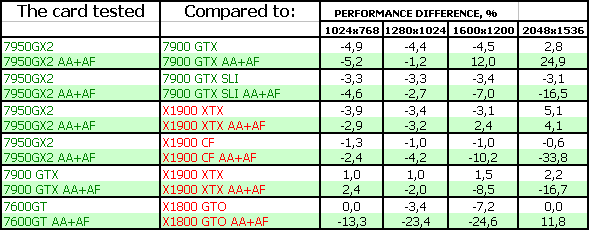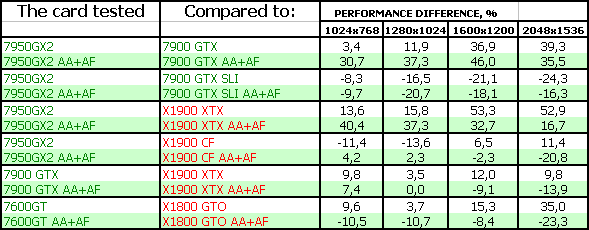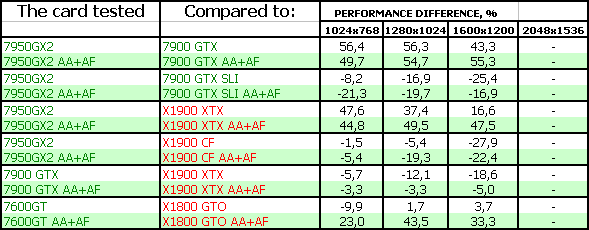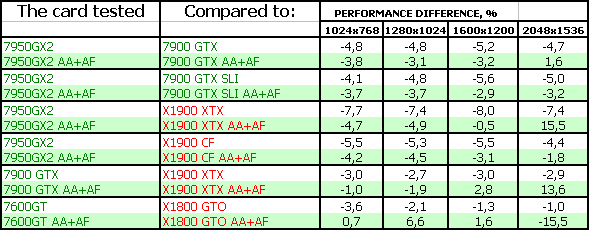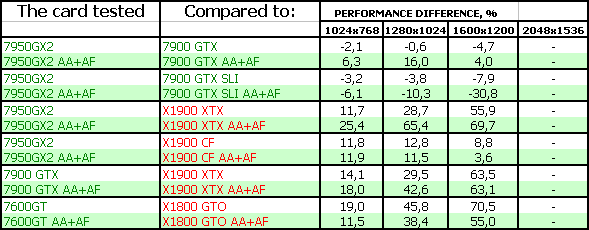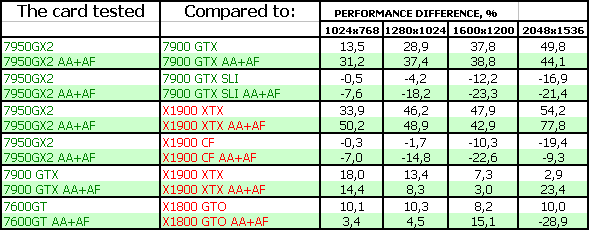ASUS EN7600GT Silent 256MB PCI-E
ASUS EN7900GTX 512MB PCI-E
ASUS EN7950GX2 1024MB PCI-E
|
TABLE OF CONTENTS
- Introduction
- Video cards' features
- Testbed configurations, benchmarks
- Test results
- Conclusions
The summer is in full swing. But unlike the last year, there are no new 3D accelerators so far. However, a new product that appeared in spring (GeForce 7950 GX2) is still conquering the market. So it looks like the only new Hi-End accelerator.
Today we are going to review three products from ASUSTeK, one of them being the 7950 card. It's a great pity that all the engineers did was to install a noiseless cooler from ASUS on GeForce 7600 GT. All the three cards are manufactured by NVIDIA's orders on unknown plants. Partners, including ASUSTeK, just buy ready cards.
Long gone are unique designs of the company, when the cards had built-in monitoring tools and other interesting features. On one hand, it's understandable: the reference design currently provides control over temperature conditions as well as cooler rpm, frequencies, etc. But these features are often available only through third-party utilities, like RivaTuner (thanks to its author Alexei Nikolaychuk!), which are available only to a relatively small group of users (firstly, due to limited availability of Internet; secondly, even Internet users may not know about this program). Native SmartDoctor is becoming just an overclocking utility, it does no monitoring, though it was promised. Alas, that's not true. So you should all download RivaTuner at the link above and use this program for finetuning and monitoring.
I repeat that today we are going to review three reference cards, ASUSTeK has nothing to do with their manufacturing (I mean the cards themselves!) Only one of the products has a proprietary cooling system from ASUS.
Let's examine these accelerators. Besides, bundles play an important role.
Video Cards
|
ASUS EN7600GT Silent 256MB PCI-E
|
|
GPU: GeForce 7600 GT (G73)
Interface: PCI-Express x16
GPU frequencies: 500/500/500 MHz (nominal - 500/500 (500) MHz)
Memory frequencies (physical (effective)): 700 (1400) MHz (nominal — 700 (1400) MHz)
Memory bus width: 128bit
Number of vertex pipelines: 5
Number of pixel pipelines: 12
Number of texture processors: 12
Number of ROPs: 8
Dimensions: 180x100x22mm (the last figure is the maximum thickness of a video card). We don't take into account dimensions of the remote part of the heatsink, as it can be rotated to find a convenient position.
PCB color: green.
Output connectors: 2 x DVI, TV-Out.
VIVO: not available
TV-out: integrated into GPU.
|

|
|
ASUS EN7900GTX 512MB PCI-E
|
|
GPU: GeForce 7900 GTX (G71)
Interface: PCI-Express x16
GPU frequencies: 650/650/700 MHz (nominal - 650/650/700 MHz)
Memory frequencies (physical (effective)): 800 (1600) MHz (nominal — 800 (1600) MHz)
Memory bus width: 256bit
Number of vertex pipelines: 8
Number of pixel pipelines: 24
Number of texture processors: 24
Number of ROPs: 16
Dimensions: 205x100x32mm (the last figure is the maximum thickness of a video card).
PCB color: green.
Output connectors: 2§DVI, TV-Out.
VIVO: not available
TV-out: integrated into GPU.
|
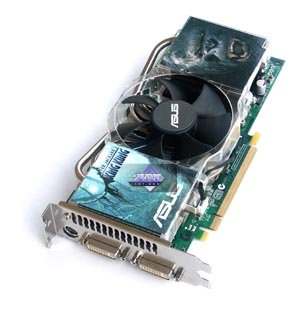
|
|
ASUS EN7950GX2 1024MB PCI-E
|
|
GPU: 2 x GeForce 7950 GX2 (G71)
Interface: PCI-Express x16
GPU frequencies: 500/500/500 MHz (nominal - 500/500 (500) MHz)
Memory frequencies (physical (effective)): 600 (1200) MHz (nominal — 600 (1200) MHz)
Memory bus width: 2 x 256bit
Number of Shader Vertex Processors: 2 x 8
Number of Shader Pixel Processors: 2 x 24
Number of texture processors: 2 x 24
Number of ROPs: 2 x 16
Dimensions: 210x100x32mm (the last figure is the maximum thickness of a video card).
PCB color: green.
Output connectors: 2 x DVI (Dual-Link), TV-Out.
VIVO: not available
TV-out: integrated into GPU.
|

|
|
ASUS EN7600GT Silent 256MB PCI-E |
|
The video card has 256 MB of GDDR3 SDRAM allocated in four chips on the front side of the PCB.
Samsung (GDDR3) memory chips. 1.4ns memory access time, which corresponds to 700 (1400) MHz.
|
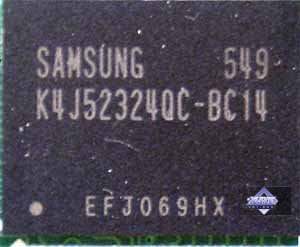
|
|
ASUS EN7900GTX 512MB PCI-E
|
|
The video card has 512 MB of GDDR3 SDRAM allocated in eight chips on the front side of the PCB.
Samsung (GDDR3) memory chips. 1.1ns memory access time, which corresponds to 900 (1800) MHz.
|

|
|
ASUS EN7950GX2 1024MB PCI-E
|
|
The video card has 1024 MB of GDDR3 SDRAM allocated in eight chips on the front side of each PCB (16 chips in total).
Samsung (GDDR3) memory chips. 1.4ns memory access time, which corresponds to 700 (1400) MHz.
|

|
|
Comparison with the reference design, front view
|
|
ASUS EN7600GT Silent 256MB PCI-E
|
Reference card NVIDIA GeForce 7600 GT
|

|
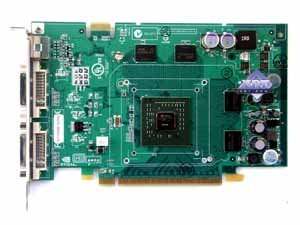
|
|
ASUS EN7900GTX 512MB PCI-E
|
Reference card NVIDIA GeForce 7900 GTX
|

|
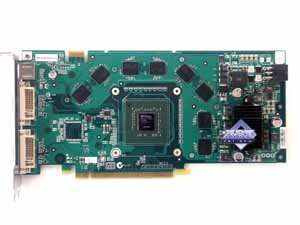
|
|
ASUS EN7950GX2 1024MB PCI-E
|
Reference card NVIDIA GeForce 7950 GX2
|
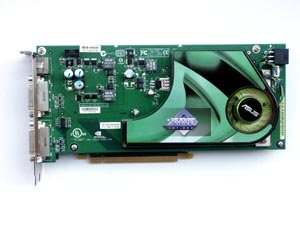
|

|

|

|
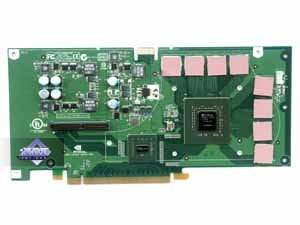
|

|
|
Comparison with the reference design, back view
|
|
ASUS EN7600GT Silent 256MB PCI-E
|
Reference card NVIDIA GeForce 7600 GT
|

|

|
|
ASUS EN7900GTX 512MB PCI-E
|
Reference card NVIDIA GeForce 7900 GTX
|

|

|
|
ASUS EN7950GX2 1024MB PCI-E
|
Reference card NVIDIA GeForce 7950 GX2
|

|

|
The photos above support my thesis that all these cards are of the reference design. Theoretically, we could have skipped the photos, but for a special cooler in one of the cards - these are just reference cards, only stickers on their cooling systems mention ASUSTeK.
All the cards have TV-Out with a unique jack. You will need a special bundled adapter to output video to a TV-set via S-Video or RCA. You can read about the TV-Out in more detail
here.
Analog monitors with d-Sub (VGA) interface are connected with special DVI-to-d-Sub adapters. Maximum resolutions and frequencies:
- 240 Hz Max Refresh Rate
- 2048 x 1536 x 32bit x85Hz Max - analog interface
- 2560 x 1600 @ 60Hz Max - digital interface (in the 7600 GT card, this resolution is supported only by the bottom DVI connector!)
|
ASUS EN7600GT Silent 256MB PCI-E
|
|
It's a very complex and intricate device on the face of it. However, all this multitude of screws, nuts, angle pieces hides an interesting system: the card is equipped with a large heatsink, which uses a heat pipe to channel the heat to the second pin-fin copper heatsink. We have already come across this many times, the second heatsink mounted at the back of the card and the heat pipe bending around the card on top or at the side. This design might have worked in this case as well, as 560 MHz G73 chips do not get very hot.
However, the main disadvantage of that cooling system with two heatsinks is insufficient cooling for the second heatsink. When it's pressed to the PCB, it blocks the cool air flow from PC case fans.
Lifting this heatsink ABOVE the card provides a good cooling effect and the rotation capacity allows flexibility in arranging the heatsink inside a PC case (for example, the air usually flows past a CPU cooler, so placing a copper pin-fin heatsink of the video card on this way is very useful; besides, the hot air is driven out of a PC case).
Of course, some users will find this cooling system clumsy, ridiculous, and even impeding (there exist different PC cases). I just agree that this cooler is not very graceful. It looks as though it's assembled from improvised angle pieces and other materials. But I repeat that it's truly efficient, the engineers did a good job. Well, the design may be disputable, though all you will be able to see from a window at the side of your PC case (if there is a window at all) is the top heatsink.
|

|

|
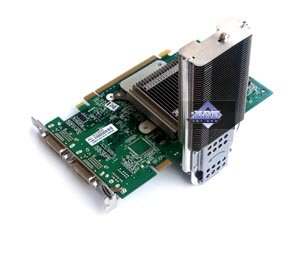
|

|
|
ASUS EN7900GTX 512MB PCI-E
|
|
The cooling system is copied from 7800 GTX 512MB. That's the right decision, because it's an excellent cooler in every respect.
Despite its dimensions and seeming complexity, the device operates in a simple way: a large fan drives the air through the left and right heatsinks, which are connected to heat pipes that channel the heat from the platform, pressed to the core and memory chips. There are textile elements, impregnated with special paste, between the platform and the above mentioned components. There is a copper plate with well-polished surface to contact the GPU. Don't try to close your ears in expectance of the noise from this cooler! The fan rotates at just 1000 rpm! So there is just no noise! Of course, the cooler accelerates to about 4000-5000 rpm and gets noisy at system startup, but that's for just 5-6 seconds. It does not howl like the cooler from the RADEON X1900.
The cooling system is bulky and takes up an adjacent slot, but that's not a vital problem nowadays, I guess.
What's important, the cooler drives the hot air out of a PC case at least partially.
|
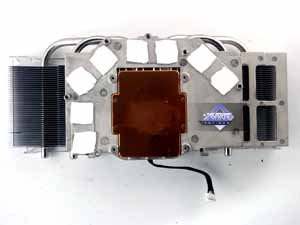
|
|
ASUS EN7950GX2 1024MB PCI-E
|
|
What is GeForce 7950 GX2? It's two GeForce 7900 GTX chips operating at reduced frequencies in SLI mode on a single card. That is two G71 accelerators operate in a single slot. The photos above show the 7950 card in the exploded form (each part of the "sandwich" plus an adapter) as well as assembled with a cooler.
The price of compact dimensions (compared to two 7900 GTX cards) is reduced operating frequencies. Memory frequencies in the first place, as it's impossible to arrange the chips in a semicircle around the core. So the chips will be at different distances from the GPU, which implies some limitations. We can see that the 1.4ns memory (nominal 700 MHz) operates just at 600 MHz (safety margin, lower power consumption and consequently lower heat release.)
Two components are responsible for SLI: a chip on the second card (the one with the PCI-E connector - it's on the bottom of the photo below), which is just a modified HSI (PCIE-to-PCIE), and an adapter inserted into special connectors on both parts of our sandwich.
As a result, we got a compact solution.
But engineers had to use very thin coolers, which limited the range of core frequencies, so it was reduced from 650 MHz to 500 MHz.
As we can see, these are just ordinary cooling systems. A closed heatsink and a fan that drives the air through it. Such a form with an elongated tail is intended to cool chips of the bridge that unites both parts of the accelerator. The core touches a copper plate soldered into the heatsink.
|
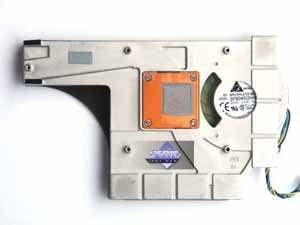
|

|

|
Bundle
|
ASUS EN7600GT Silent 256MB PCI-E
|
|
User manual, CD with drivers, CD with the manual in multiple languages, games - King-Kong, XPand Rally; DVI-to-d-Sub and composite adapters. Bonus - leather album for compact discs.
|

|

|
|
ASUS EN7900GTX 512MB PCI-E
|
|
User's guide, CD with drivers, ASUSDVD, CD with a manual in many languages, Virtual Drive 9, a set of old games; adapters - DVI-to-d-Sub and composite-out. There is no CD album as a bonus.
|
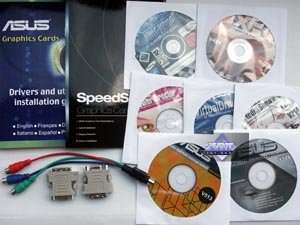
|

|
|
ASUS EN7950GX2 1024MB PCI-E
|
|
User manual, CD with drivers, CD with the manual in multiple languages, games - King-Kong, Snowblind; DVI-to-d-Sub and composite adapters. There is a bonus again - a leather album for compact discs. |

|

|
Packages.
|
ASUS EN7600GT Silent 256MB PCI-E
|
|
All the three boxes are as like as three peas. The only differences are in background colors and labels.
|

|
|
ASUS EN7900GTX 512MB PCI-E
|
|
These are traditional huge boxes in ASUS style :-). A bright jacket covers a white cardboard box with a handle. All components are arranged into sections inside, cards are secured in a box made of foamed polyurethane.
|

|
|
ASUS EN7950GX2 1024MB PCI-E
|
|
Unfortunately, the company decided to give up box windows. Too bad. The box dimensions are still large, the empty room is just wasted.
|

|
Installation and Drivers
Testbed configuration:
- Athlon 64 (939Socket) based computer
- CPU: AMD Athlon 4000+ (2400MHz) (L2=1024K)
- Motherboard: ASUS A8N32 SLI Deluxe on NVIDIA nForce4 SLI X16
- RAM: 2 GB DDR SDRAM 400MHz (CAS (tCL)=2.5; RAS to CAS delay (tRCD)=3; Row Precharge (tRP)=3; tRAS=6)
- HDD: WD Caviar SE WD1600JD 160GB SATA
- Operating system: Windows XP SP2 DirectX 9.0c
- Monitors: ViewSonic P810 (21") and Mitsubishi Diamond Pro 2070sb (21").
- ATI Drivers (PCI-E video cards) CATALYST 6.5; NVIDIA Drivers 91.28\91.31.
VSync is disabled.
What concerns overclocking (without additional cooling inside a closed PC case with one fan blowing the air in and the other blowing the air out), the situation is as follows:
- ASUS EN7600GT Silent 256MB PCI-E - 620/1470 MHz;
- ASUS EN7900GTX 512MB PCI-E - 700/1760 MHz;
- ASUS EN7950GX2 1024MB PCI-E - 560/1320 MHz;
We have already reviewed temperature conditions of 7900GTX and 7950GX2, but the 7600 GT with its passive cooling system is very interesting in this respect.
We have analyzed operating temperatures of the 7600 GT using RivaTuner (conditions are described above). The core temperature reached 80°C. Considering that the card was not cooled additionally and it worked in a closed PC case, it's a very good result. For the card. The question is what effect it has on the conditions inside a system unit. In my case, the temperature inside grew by 10°C. So a well-ventilated PC case is necessary anyway.
Test results: performance comparison
We used the following test applications:
Summary performance diagrams
Game tests that heavily load vertex shaders, mixed pixel shaders 1.1 and 2.0, active multitexturing.
FarCry, Research
Test results: FarCry Research
Game tests that heavily load vertex shaders, pixel shaders 2.0, active multitexturing.
F.E.A.R.
Test results: F.E.A.R
Splinter Cell Chaos Theory
Test results: SCCT
Call Of Duty 2 DEMO
Test results: COD2
Half-Life2: ixbt01 demo
Test results: Half-Life2, ixbt01
Game tests that heavily load pixel pipelines with texturing, active operations of the stencil buffer and shader units
DOOM III High mode
Test results: DOOM III
Chronicles of Riddick, demo 44
Test results: Chronicles of Riddick, demo 44
Synthetic tests that heavily load shader units
3DMark05: MARKS
Test results: 3DMark05 MARKS
3DMark06: Shader 2.0 MARKS
Test results: 3DMark06 Shader 2.0 MARKS
3DMark06: Shader 3.0 MARKS
Test results: 3DMark06 Shader 3.0 MARKS
You can find our comments in the conclusions.
Conclusions
So:
- ASUS EN7600GT Silent 256MB PCI-E is a very interesting Middle-End solution with a noiseless cooler. The X1800 GTO outscores the 7600 GT in some parameters (256bit bus, sometimes faster, HDR+AA support, anisotropy of higher quality), but it's more expensive as a rule. The accelerator worked fine, we had no problems with it, the card demonstrated excellent 2D quality in 1600§1200@100Hz. I also want to mention the bundle with a bonus.
- ASUS EN7900GTX 512MB PCI-E is a copy of the reference card. It's a High-End accelerator, not the most powerful from the line of NVIDIA single cards (it takes up a single PCI-E slot - not a usual SLI), but it competes well with the X1900 XTX in price. However, the X1900 XTX may be more interesting, if it has the same price (we already wrote about it). The card offers excellent quality. It worked great, its 2D quality was on the same level as in the previous product.
- ASUS EN7950GX2 1024MB PCI-E is again a reference copy. There is nothing much to add. According to our tests, it's currently the fastest single-slot accelerator.
Yep, the X1900 XTX card sometimes catches up and even outperforms the new model from NVIDIA. But it happens, when its performance is limited by system resources. Results are unpredictable in this case. The X1900 XT CF turned out faster, but the price for two X1900 XT (CFE) is much higher.
So, the 7950 GX2 card is certainly a king among single accelerators. The price will be approximately $650.
I also want to note that the video card was stable, we had no gripes with it. The cooler is not noisy, it did not speed up to maximum, even though the core temperature reached 90°C and higher. Unfortunately, you cannot replace a cooler on this video card, there are no counterparts.
Its 2D quality is just as excellent.
I repeat that NONE of NVIDIA partners manufacture GeForce 7900 GTX, GeForce 7950 GX2 on their own! All of them buy ready cards from NVIDIA, which places orders to third-party plants. It had started back in 2002 with NVIDIA GeForce FX 5800 (NV30). So it's silly to say that GeForce 7900 GTX/7950 GX2 cards from Leadtek or Palit are of less quality than from Gigabyte or MSI. All the cards are identical. The difference is only in bundles.
You can find more detailed comparisons of various video cards in our 3Digest.
The following cards get the Excellent Package award (July 2006):
- ASUS EN7600GT Silent 256MB PCI-E
- ASUS EN7950GX2 1024MB PCI-E
We express our thanks to
ASUSTeK Russia
for the provided video cards.
PSU for the testbed was kindly provided by HIPER
 Andrey Vorobiev (anvakams@ixbt.com)
Andrey Vorobiev (anvakams@ixbt.com)
July 18, 2006
Write a comment below. No registration needed!
|
|
 |
|
|
|


